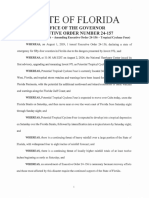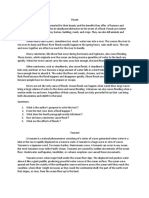0 ratings0% found this document useful (0 votes)
1 viewsG9-SS-NS- Climate 24-25
G9-SS-NS- Climate 24-25
Uploaded by
shankarkrishnashanojSocial notes
Copyright:
© All Rights Reserved
Available Formats
Download as PDF, TXT or read online from Scribd
G9-SS-NS- Climate 24-25
G9-SS-NS- Climate 24-25
Uploaded by
shankarkrishnashanoj0 ratings0% found this document useful (0 votes)
1 views2 pagesSocial notes
Copyright
© © All Rights Reserved
Available Formats
PDF, TXT or read online from Scribd
Share this document
Did you find this document useful?
Is this content inappropriate?
Social notes
Copyright:
© All Rights Reserved
Available Formats
Download as PDF, TXT or read online from Scribd
Download as pdf or txt
0 ratings0% found this document useful (0 votes)
1 views2 pagesG9-SS-NS- Climate 24-25
G9-SS-NS- Climate 24-25
Uploaded by
shankarkrishnashanojSocial notes
Copyright:
© All Rights Reserved
Available Formats
Download as PDF, TXT or read online from Scribd
Download as pdf or txt
You are on page 1of 2
M.E.
S INDIAN SCHOOL (MESIS)
ABU HAMOUR BRANCH, DOHA – QATAR
NOTES [2024-2025]
Class &Div: IX (All Divisions) Subject: Social Science
Lesson: Climate Date: 10/10/2024
=====================================================================================================
Ref. No: S.S-NS-16
1. Distinguish between climate and weather.
Answer: Climate refers to the sum total of weather conditions and variations over a large
area for a long period of time (thirty years).
Weather refers to the state of the atmosphere over an area at any point of time.
2. Name the elements of climate and weather.
Answer:Elements of weather and climate are temperature, atmospheric pressure, wind,
humidity and precipitation.
3. What does the word ‘Monsoon’ mean?
Answer:The word Monsoon is derived from the Arabic word ‘mausim’ which literally
means season. It refers to the seasonal reversal in the wind direction during a year.
4. What is the climate of India?
Answer:India’s climate is described as “Tropical Monsoon Type of Climate”.
5. Name the two elements which are responsible for the regional variations within the
country.
Answer:The two important elements are temperature and precipitation.
6. Why do the houses in Rajasthan have thick walls and flat roofs?
Answer:The houses in Rajasthan have thick walls to prevent them from becoming hot. The
thick walls keep the interior cool. The flat roofs are used to collect water when it rains and
in summer they are used for drying dates and storage purposes.
7. Why are houses in Assam built on stilts?
Answer:Assam receives very heavy rain and often water accumulates on the ground. There
is a thick undergrowth which makes it difficult for the people to live. So houses are built
above the ground level on stilts.
8. Explain the term ‘burst’ of the monsoon.
Answer:Around the time of its arrival, the normal rainfall suddenly increases and it
continues to rain for several days. This is known as the ‘burst’ of the monsoon.
9. Give two examples of pre-monsoon showers.
Answer:The two examples of pre-monsoon showers are the ‘mango showers’ in Kerala and
Karnataka and the ‘Kaal Baisakhi’ which causes rainfall in West Bengal.
10. Name the major seasons of India.
Answer:(a) The cold weather season (winter) (b) The hot weather season (summer)
(c) Rainy season (d) Retreating season
ACD-105, REV 0, 27.03.2021
11. Explain the features of the Monsoon rains.
Answer:(a) The Monsoon is often irregular in its arrival and retreat.
(b) The rainfall is unevenly distributed. Certain regions lying on the windward slopes of the
mountains receive heavy rain while those in the rain shadow area receives less.
(c) The amount of rain varies annually.
(d) The rainfall is concentrated within the three months of the year.
(e) The alternation of dry and wet spells vary in intensity. At one place the rainfall is very heavy
causing floods while at another place it might have famines.
12. Write a brief account of the conditions and characteristics of the retreating monsoons.
Answer: The months of October-November mark a period of transition from hot rainy
season to cold dry winter conditions. The Retreating Monsoon season is marked by clear
skies and rise in temperature. While days are warm, nights are cool and pleasant. High rate
of evaporation from the land that is still moist results in high humidity and oppressive
weather conditions during the day. This phenomenon is known as ‘October heat’.
13. Give a brief account of the hot weather season in India.
Answer :The period between March to May is the hot weather season or summer in India.
The summer months experience rising temperature and falling air pressure in the northern
part of the country. Towards the end of May, an elongated low-pressure area develops in
the region extending from the Thar Desert in the northwest to Patna and Chotanagpur
plateau in the east and southeast. Circulation of air begins to set in around this trough.
Strong, gusty, hot, dry winds, locally called ‘loo’, blow during the day over the north and
northwestern India. They may continue until late in the evening. Dust storms are common
during the month of May in Punjab, Haryana, Delhi, Eastern Rajasthan and Western Uttar
Pradesh. Sometimes, they bring light rain and pleasant cool breeze that provide temporary
relief from the heat. High temperature during the day causes violent, localised
thunderstorms by the evening. These thunderstorms are associated with violent winds,
torrential downpours, often accompanied by hail. These storms are known as ‘Kaal
Baisakhi’ or calamity of the month of Baisakh in West Bengal.
*****************
ACD-105, REV 0, 27.03.2021
You might also like
- Updated Executive Order State of Emergency August 2Document2 pagesUpdated Executive Order State of Emergency August 2ABC Action NewsNo ratings yet
- Notes of Chapter-ClimateDocument3 pagesNotes of Chapter-Climatemouliksingla786No ratings yet
- 9 GeographyDocument5 pages9 GeographyVishal DeyNo ratings yet
- SST PDF Class 9Document15 pagesSST PDF Class 9Snehal JainNo ratings yet
- Climate Class 9thDocument6 pagesClimate Class 9thsafwanrather93No ratings yet
- Geo. Worksheet Ch-4 ClimateDocument4 pagesGeo. Worksheet Ch-4 ClimatezyndexgamingytNo ratings yet
- Climate - Important QuestionsDocument11 pagesClimate - Important QuestionsR.M. SundaramNo ratings yet
- CLIMATE class 9 (1)Document6 pagesCLIMATE class 9 (1)Ayan BiswasNo ratings yet
- FINAL Grade 9-Climate Question BankDocument9 pagesFINAL Grade 9-Climate Question Bankdhageravi271No ratings yet
- Geography Handout Class IX Ch4: ClimateDocument11 pagesGeography Handout Class IX Ch4: ClimateRanvijay SinghNo ratings yet
- Class 9 Geography Chapter 4 Climate Important Questions – Study PathDocument9 pagesClass 9 Geography Chapter 4 Climate Important Questions – Study Paththanksforeverything162No ratings yet
- Geo Work CH 4 ClimateDocument11 pagesGeo Work CH 4 Climatemayankbrar10No ratings yet
- CH 4Document2 pagesCH 4akhileshNo ratings yet
- Climate Easy and Detailed Notes For Class 9thDocument6 pagesClimate Easy and Detailed Notes For Class 9thkingX GamingNo ratings yet
- Ix Geo. ClimateDocument5 pagesIx Geo. Climatepriyankaganga.viharNo ratings yet
- 8.the Climate of Our CountryDocument2 pages8.the Climate of Our CountryAbhinav ReddyNo ratings yet
- Class 9 Social Science Contemporary India Chapter 4 - ClimateDocument6 pagesClass 9 Social Science Contemporary India Chapter 4 - ClimateThe venom Dude UGM (Mews)No ratings yet
- NCERT Solutions Class 9 Social Science Geography Chapter 4 ClimateDocument6 pagesNCERT Solutions Class 9 Social Science Geography Chapter 4 ClimateHarpreet KaurNo ratings yet
- CLIMATEDocument9 pagesCLIMATEg140359reshmi.gbkmNo ratings yet
- ClimateDocument4 pagesClimateS.AbhinavNo ratings yet
- 9081498-QB.No.4. Class.IX Climate(Geo)Gurjinder Kaur. 2023-24Document5 pages9081498-QB.No.4. Class.IX Climate(Geo)Gurjinder Kaur. 2023-24AnushaNo ratings yet
- 9 Geography Chapter 4 ClimateDocument7 pages9 Geography Chapter 4 ClimateSeema AgrawalNo ratings yet
- CLIMATE SST NotesDocument7 pagesCLIMATE SST NotesParinita JamuarNo ratings yet
- Solutions- Chapter-ClimateDocument5 pagesSolutions- Chapter-ClimatePrakash kumarNo ratings yet
- CLIMATE - AssignmentDocument3 pagesCLIMATE - Assignmentrishubansal37641No ratings yet
- Climate: Module - 2Document19 pagesClimate: Module - 2SatyajitMohapatraNo ratings yet
- Class-9-Geography-Chapter-Climate (1)Document9 pagesClass-9-Geography-Chapter-Climate (1)AZAMNo ratings yet
- Class-9-Geography-Chapter-ClimateDocument8 pagesClass-9-Geography-Chapter-ClimatevigneshodNo ratings yet
- 7 ZMNLFL Yk 6 B 4 LZJP G4 XXDocument15 pages7 ZMNLFL Yk 6 B 4 LZJP G4 XXprincejaisawal2mNo ratings yet
- Climate (1) SetDocument6 pagesClimate (1) SetSradhanjali KarNo ratings yet
- Schools Aglasem ComDocument11 pagesSchools Aglasem ComHarataRongpiNo ratings yet
- Questionbankforfirst 5 ChaptersDocument43 pagesQuestionbankforfirst 5 ChaptersShalini AravindanNo ratings yet
- Ls.4 Climate NCERT SolutionsDocument5 pagesLs.4 Climate NCERT Solutionskhushaliramani02No ratings yet
- 10 Icse GeographyDocument5 pages10 Icse Geographygargi.kadamNo ratings yet
- GEOGRAPHY CH-4Document5 pagesGEOGRAPHY CH-4jatin.poonia7187No ratings yet
- ClimateDocument3 pagesClimateVyiga ManojNo ratings yet
- Lms - 2022 05 27 - 10 46 53Document6 pagesLms - 2022 05 27 - 10 46 53sujalprajapati109No ratings yet
- NCERT Solutions For Class 9 Geography Chapter 4 Climate FREE PDFDocument8 pagesNCERT Solutions For Class 9 Geography Chapter 4 Climate FREE PDFKarthikNo ratings yet
- Climate Class IxDocument6 pagesClimate Class Ixshlokchavan94No ratings yet
- GIDB5220256 CLIMATE NotesDocument4 pagesGIDB5220256 CLIMATE NotesSprihi SharmaNo ratings yet
- SELF ASSESSMENT WORKSHEET For CLASS 9. Geography, Chapter 4, CLIMATEDocument8 pagesSELF ASSESSMENT WORKSHEET For CLASS 9. Geography, Chapter 4, CLIMATEVinayak Parashar100% (1)
- Cbse 9th Geography SummaryDocument27 pagesCbse 9th Geography SummarySwarna kadagalaNo ratings yet
- Climate of India - 094032Document7 pagesClimate of India - 094032YatharthNo ratings yet
- CSK W CHAPTER CLIMATEDocument4 pagesCSK W CHAPTER CLIMATEJapmeet sethiNo ratings yet
- Climate Notes Geo Class9 Term2Document7 pagesClimate Notes Geo Class9 Term2vinod157767% (3)
- O 4 NotesDocument5 pagesO 4 NotesdangisamarthsinghNo ratings yet
- NCERT Solutions For Class 9 Geography Chapter 4 ClimateDocument5 pagesNCERT Solutions For Class 9 Geography Chapter 4 ClimateamitanjudalalNo ratings yet
- Climate-Que/and Class 9 Geo PDFDocument13 pagesClimate-Que/and Class 9 Geo PDFitusingla0104No ratings yet
- Climate NotesDocument4 pagesClimate NotesCyberKNo ratings yet
- IX Worksheet S.st. - 21 (G-4)Document3 pagesIX Worksheet S.st. - 21 (G-4)Shubh JainNo ratings yet
- L4 Climate NotesDocument5 pagesL4 Climate Notesanshbeniwal1407No ratings yet
- Q and A Climate LessonDocument5 pagesQ and A Climate Lessonsparsh.shah11424No ratings yet
- Class IX - Chapter 4 (Climate) Question & AnswerDocument18 pagesClass IX - Chapter 4 (Climate) Question & AnswerRajkumar Jain82% (11)
- S.St. Chapter-6 JULY-2020 Class-5 Q&Ans 18-6-20Document2 pagesS.St. Chapter-6 JULY-2020 Class-5 Q&Ans 18-6-20rasiawasthiNo ratings yet
- Geography - Climate By.M.KrishnamoorthyDocument20 pagesGeography - Climate By.M.Krishnamoorthyjeevasowmya71No ratings yet
- Usp Case Study ClimateDocument8 pagesUsp Case Study ClimatePuja Bhardwaj100% (1)
- Climate Question and AnswerDocument12 pagesClimate Question and Answerr.kavitharamasamyNo ratings yet
- climate longDocument7 pagesclimate longankit426689No ratings yet
- Climate Solved worksheet (1)Document8 pagesClimate Solved worksheet (1)ammaarzariartNo ratings yet
- CH 2Document28 pagesCH 2ADIL DURRANINo ratings yet
- José Andrés World KitchenDocument3 pagesJosé Andrés World KitchenEl javas 7491No ratings yet
- Super Typhoon NoruDocument1 pageSuper Typhoon NoruShelly AgatsumaNo ratings yet
- NSTP Report BSN 1-3 DRRM First AidDocument2 pagesNSTP Report BSN 1-3 DRRM First AidALEGRIA BEGINONo ratings yet
- Lab Exercise 06Document3 pagesLab Exercise 06Tin LumantasNo ratings yet
- Tropical Disturbance: Tropical Waves, Easterly Waves, or Tropical Easterly Waves, Also Known As African Easterly WavesDocument1 pageTropical Disturbance: Tropical Waves, Easterly Waves, or Tropical Easterly Waves, Also Known As African Easterly WavesRamil L. AbuanNo ratings yet
- Module 2 QuizDocument2 pagesModule 2 QuizJasminka TrajkovskaNo ratings yet
- Detailed Lesson Plan: Science VDocument8 pagesDetailed Lesson Plan: Science VJerome DesameroNo ratings yet
- Hegler - After The StormDocument8 pagesHegler - After The StormMadina ZamanovaNo ratings yet
- Conditions of The Environment Before, During andDocument80 pagesConditions of The Environment Before, During andRichard CruzNo ratings yet
- G8 Science Q2 - Week 4 - TyphoonDocument25 pagesG8 Science Q2 - Week 4 - TyphoonAlvin RudioNo ratings yet
- List of Typhoon Occurrences in CoronDocument2 pagesList of Typhoon Occurrences in CoronPhen MontalboNo ratings yet
- General Preparedness Tips: Know Your RisksDocument4 pagesGeneral Preparedness Tips: Know Your RisksJeahun KimNo ratings yet
- D091201024 - Rizaldi Darlis - FinalBhsInggrisDocument2 pagesD091201024 - Rizaldi Darlis - FinalBhsInggrisRizaldi DarlisNo ratings yet
- Eugenio G. Sy Tamco Elementary SchoolDocument5 pagesEugenio G. Sy Tamco Elementary SchoolRachel Anne TapangNo ratings yet
- 2005 Assam Bihar FloodDocument7 pages2005 Assam Bihar Flooddaniyal rasheedNo ratings yet
- FloodsDocument2 pagesFloodsIndra LaksonoNo ratings yet
- Upcoming Hurricane NamesDocument1 pageUpcoming Hurricane NamesNewsdayNo ratings yet
- HDC Anh 8 GKII 2023-2024Document2 pagesHDC Anh 8 GKII 2023-2024giasutaihue1No ratings yet
- Cyclone:: Cyclone, Types, Effects and Formation of CycloneDocument3 pagesCyclone:: Cyclone, Types, Effects and Formation of CycloneprachiNo ratings yet
- Tips To Help You Stay Safe During A Calamity: EarthquakesDocument2 pagesTips To Help You Stay Safe During A Calamity: EarthquakesThemis ArtemisNo ratings yet
- CROSSWORD PUZZLE FOR TROPICAL CY 3cedb5 6184a9fdDocument1 pageCROSSWORD PUZZLE FOR TROPICAL CY 3cedb5 6184a9fdjunaidapanonte01No ratings yet
- Media Release: Hurricane Sandy UpdateDocument1 pageMedia Release: Hurricane Sandy Updateapi-94436539No ratings yet
- NDRRMC Update Sitrep 5 TS DanteDocument96 pagesNDRRMC Update Sitrep 5 TS DanteDex CabalzaNo ratings yet
- DRRRDocument1 pageDRRRRizalyn GarciaNo ratings yet
- 123 Rule For TRS MMD DG ShippingDocument2 pages123 Rule For TRS MMD DG ShippingGurjit SinghNo ratings yet
- DRRR - Mod 2 - Vulnerability of The Philippines To DisasterDocument25 pagesDRRR - Mod 2 - Vulnerability of The Philippines To DisasterKyla Camille VicencioNo ratings yet
- Activity 3. Tracking A Tropical Cyclone - MAMURIDocument4 pagesActivity 3. Tracking A Tropical Cyclone - MAMURIEirik Nathan MamuriNo ratings yet
- Period of Lesson: 3 Days Lesson Plan in Science V Topic: Tropical CyclonesDocument5 pagesPeriod of Lesson: 3 Days Lesson Plan in Science V Topic: Tropical CyclonesCarl James MingoNo ratings yet
- Science 8 DLLDocument4 pagesScience 8 DLLSophia Acer Artates100% (1)

























































































